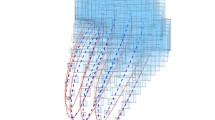Abstract
This paper considers the problem of controlling both position and attitude states for a formation flying system using only thrusters. A coupled six degree of freedom position and attitude model is derived, where the coupling comes from the gravity gradient torque. Furthermore, the J2 perturbation, mass variation, thruster model, and thruster layout are considered. A globally stable chattering free sliding mode robust controller is designed with respect to functional bounded uncertainties. Based on the studies of open-loop responses, the range of control parameters is properly selected to avoid thruster saturation. A genetic algorithm is then applied to select the controller parameters. Both position and attitude states in a formation are precisely and continuously controlled for more than two years without recharging, using the selected electronic ion engine.
Similar content being viewed by others
References
CLOHESSY, W.H. and WILTSHIRE, R. S. “Terminal Guidance Systems for Satellite Rendezvous,” Journal of the Aerospace Sciences, Vol. 27, Sept. 1960, pp. 653–658 and p. 674.
VISSAR, R. H. and SHERWOOD, R. B. “Formation Keeping for a Pair of Satellites in a Circular Orbit,” Journal of Guidance, Control, and Dynamics, Vol. 8, No. 2, March-April 1985, pp. 235–242.
REDDING, D. C. and ADAMS, J. “Linear-Quadratic Station Keeping for the STS Orbiter,” Journal of Guidance, Control, and Dynamics, Vol. 12, No. 2, March-April 1989, pp. 248–255.
INALHAN, G., TILLERSON, M., and HOW, J. P. “Relative Dynamics and Control of Spacecraft Formations in Eccentric Orbits,” Journal of Guidance, Control, and Dynamics, Vol. 25, No. 1, January-February 2002, pp. 48–59.
XU, Y. and FITZ-COY, N. G. “Generalized Relative Dynamics and Control in Formation Flying System,” presented as paper AAS 03–011 at the 26th Annual AAS Guidance and Control Conference, Breckenridge, Colorado, February 5–9, 2003.
XU, Y. and FITZ-COY, N. G. “Genetic Algorithm Based Sliding Mode Control in the Leader/Follower Satellites Pair Maintenance,” presented as paper AAS 03–648 at the 2003 AAS/AIAA Astrodynamics Specialist Conference, Big Sky, Montana, August 3–7, 2003.
PERRUQUETTI, W. and BARBOT, J. P. Sliding Mode Control in Engineering, Marcel Dekker, Inc., New York, 2002, pp. 12–14.
SLOTINE, J. E. and LI, W. (editors) Applied Nonlinear Control, Prentice Hall, Englewood Cliffs, New Jersey, 1990, pp. 267–307.
BARTOLINI, G., FERRARA, A., USAI, E., and UTKIN, V. I. “On Multi-Input Chattering-Free Second Order Sliding Mode Control,” IEEE Transaction on Automatic Control, Vol. 45, No. 9, September 2000, pp. 1711–1717.
WU, C. and CHEN, B. “Adaptive Attitude Control of Spacecraft: Mixed H2/H∞ Approach,” Journal of Guidance, Control, and Dynamics, Vol. 24, No. 4, July–August 2001, pp. 755–767.
WANG, P. K. C., HADAEGH, F. Y., and LAU, K. “Synchronized Formation Rotation and Attitude Control of Multiple Free-Flying Spacecraft,” Journal of Guidance, Control, and Dynamics, Vol. 22, No. 1, January-February 1999, pp. 28–35.
GENNARO, S. D., MONACO, S., and NORMAND-CYROT, D. “Nonlinear Digital Scheme for Attitude Tracking,” Journal of Guidance, Control, and Dynamics, Vol. 22, No. 3, May-June 1999, pp. 467–477.
AHMED, J., COPPOLA, V.T., and BERNSTEIN, D. S. “Adaptive Asymptotic Tracking of Spacecraft Attitude Motion with Inertia Matrix Identification,” Journal of Guidance, Control, and Dynamics, Vol. 21, No. 5, September 1998, pp. 684–692.
TERUI, F. “Position and Attitude Control for a Spacecraft by Sliding Mode Control,” Proceedings of the American Control Conference, Philadelphia, Pennsylvania, June, 1998, pp. 217–221.
STANSBERY, D. T. and CLOUTIER, J. R. “Position and Attitude Control of a Spacecraft Using the State-Dependent Riccati Equation Technique,” Proceedings of the American Control Conference, Chicago, Illinois, June 2000, pp. 1867–1871.
PAN, H. and KAPELA, V. “Adaptive Nonlinear Control for Spacecraft Formation Flying with Coupled Translational and Attitude Dynamics,” Proceedings of the 40th IEEE Conference on Decision and Control, Orlando, Florida, December 2001, pp. 2057–2062.
KANG, W. and SPARKS, A. “Coordinated Attitude and Formation Control of MultiSatellite Systems,” presented as paper AIAA 2002–4665 at the AIAA Guidance, Navigation, and Control Conference and Exhibit, August 5–8, 2002, Monterey, California.
MCDUFFIE, J. H. and SHTESSEL, Y. B. “A Decoupled Sliding Mode Controller and Observer for Satellite Attitude Control,” Proceedings of the American Control Conference, Albuquerque, New Mexico, June 1997, pp. 564–565.
LO, S. C. and CHEN, Y. P. “Smooth Sliding Mode Control for Spacecraft Attitude Tracking Maneuvers,” Journal of Guidance, Control, and Dynamics, Vol. 18, No. 6, 1995, pp. 1345–1349.
GOODWIN, G.C., GRAEBE, S.F., and SALGADO, M. E. (editors) Control System Design, Pearson Education (Singapore), Pte. Ltd, 2003.
BARBU, C., REGINATTO, R., TEEL, A. R., and ZACCARIAN, L. “Anti-Windup Design for Manuel Flight Control,” Proceedings of the American Control Conference, San Diego, California, June 1999, pp. 3186–3190.
BUFFINTON, J. M. and SHTESSEL, Y. B. “Saturation Protection for Feedback Linearization Systems Using Sliding Mode Theory,” Proceedings of the American Control Conference, Philadelphia, Pennsylvania, June 1998, pp. 1028–1031.
Author information
Authors and Affiliations
Corresponding author
Rights and permissions
About this article
Cite this article
Xu, Y. Sliding Mode Control and Optimization for Six DOF Satellite Formation Flying Considering Saturation. J of Astronaut Sci 53, 433–443 (2005). https://doi.org/10.1007/BF03546362
Published:
Issue Date:
DOI: https://doi.org/10.1007/BF03546362




